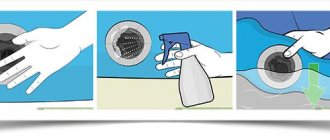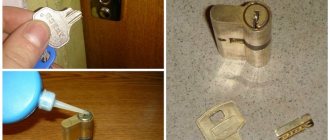Possible reason why the toilet smells like sewage
Logically, we can assume several probable reasons why the toilet smells like sewage.
- Firstly, this is ventilation.
- Secondly, the toilet itself.
- Thirdly, this is the sewerage system.
I would like to note right away that the smell from the sewer system, or rather a violation of its tightness, is the most likely cause of the smell in the toilet. However, let us analyze all the listed reasons in more detail.
I recommend starting immediately with the sewer and checking the connection system to the toilet sewer riser and the connection of sewer pipes within the toilet.
Ventilation as a cause of odor in the toilet
The likelihood that the toilet smells like sewage from the ventilation is extremely low. To do this, your neighbors (most likely from below) must have a constant serious leak of wastewater, the smell of which rises up the ventilation riser to you and you feel it.
Read: Dismantling of a plumbing cabin with a pallet and side
Toilet, what is the cause of the smell?
Each toilet is made in such a way that there is a siphon at the waste water outlet. These bend the outlet pipe to maintain a constant water level in it. In this case, water plays the role of a water barrier against the return of odors from the sewer riser through the toilet hole into the toilet room.
If the water in the hole stands and does not dry out, then we dismiss this reason.
Solving problems in a multi-storey building
Discuss the problem with your neighbors on the upper floors. In case of misunderstanding or ignoring, you should contact local organizations that maintain sewer systems. The end exit above the ceiling should be insulated. Icing is poured with hot water . After complete defrosting, the pipe is insulated.
If the house is no higher than three floors, replacing the toilet plug with a vacuum valve will help get rid of the smell.
Unpleasant smell on the upper floors
The presence of a large number of drainage systems complicates the work of one “riser”. Insufficient ventilation leads to the fact that gases released from the sewer accumulate and also leak into apartments not only on the first, but also on the top floor.
Under the roof of the house, near the riser, unscrupulous neighbors can put unnecessary things, blocking the air supply. Icing in the frosty winter also leads to congestion in the riser and the appearance of an unpleasant odor.
You can also write an application to replace the riser if it is damaged.
On the lower floors
An unscrupulous neighbor on the top floor, flushing water from a bucket into the toilet, violates the ventilation air density. A full drain discharges the air at the upper end of the riser, which may be accompanied by a loud sound. The situation can provoke a fountain from the toilet on the floors below. If the lid is not lowered, water containing impurities will spread throughout the bathroom.
If your neighbors flood your apartment, you must write a statement to the management company.
In winter, when there is severe frost, moist vapors freeze at the end of the riser , blocking the outlet. Smelling steam will accumulate and seep into the rooms, starting from the upper floors. If the outlet of the riser is not insulated, icing will become a constant problem of poor ventilation and odor. In an apartment building, it is necessary to follow the procedure for writing and submitting an application to change the riser in an apartment or house.
Thus, with the appearance of an unpleasant “aroma,” you will need to weigh all approaches to solving the problem. It is necessary to consider each of the reasons and eliminate them. If all proven methods do not help, a called specialist will help to cope with the problem.
The sewer system is the reason why the toilet smells like sewer
We've come to the main reason why the toilet smells like sewage - it's the toilet's sewage system. And here you will have to work hard.
Where to begin?
There are no alternatives, you need to start by disassembling the system and first of all you will have to remove the toilet itself.
Read: Water supply riser in an apartment and its replacement
By removing the toilet you will have access to its connection system. We consistently check and examine the connection system of the toilet itself and the sewer pipes and fittings from the toilet to the riser.
Before doing this, you need to carefully look to see if there are any visible drainage leaks from the junction of the sewer pipes and its fittings.
When disassembling the system, we look and check all the rubber parts of the connections (cuffs, sleeves, gaskets). They must be flexible, fit tightly to the pipes and not be damaged (cracks, breaks, etc.).
Since in this repair option the system has already been disassembled, I recommend replacing all the cuffs of your toilet’s sewage system with new ones.
This video will help us look at an example of eliminating odors.
Damage to sewer pipes
In a private house, where the sewage system may be hidden under buildings, it is difficult to find damage. When the drainage system malfunctions, an unpleasant odor spreads around.
In addition to the joints, the pipe may be damaged on the surface. Drain fluid will flow down the bottom of the pipe, and sewer smell will seep under the top.
Repair work
The damage needs to be found, all joints inspected, and checked for leaks. Then repair the gaps and fill the seams with sealant. You can buy it at a hardware store.
Wrap two layers of adhesive sealing tape around the damaged pipe and secure it with metal clamps. If it is not possible to check pipe connections under buildings, it will be inevitable to install a new sewer system with convenient access to all structures.
Important! You should not clear blockages yourself with sharp objects or wire, as this may cause damage to the pipes.
Temporary repair when the toilet smells like sewage?
If you don't have sewage leaks when your drain smells, you can make simple repairs that will temporarily eliminate the odors.
For repairs, you will need plumbing tape or self-adhesive aluminum LAS tape 50 mm wide. With its help, you can block the flow of return air from the riser to the toilet. It is enough to tightly wrap the area of the damaged coupling, corrugation or pipe.
Read: For a novice plumber - basic rules and some tips
Problems with the operation of the water seal
The hydraulic damper protects the room from the appearance of bad odors with its valve. It is the water column located in the bend of the cochlea under the toilet that is the valve, or water seal. This water acts as a barrier to the movement of gases formed in the sewer. Without a stopper, nothing prevents gases from passing into the toilet and spreading the smell.
Incorrect siphon installation
The siphon is located at the bottom of the plumbing fixture on the back side. It is made in the shape of a U-shaped elbow, which contains the liquid. On the toilet it goes into a large pipe, which is already connected to the sewer. Often, store sellers and ordinary buyers call a siphon the corrugation that connects the toilet to the sewer.
There are several types of pipes, depending on the design: unregulated plastic, swivel-hinge and corrugated siphon. The last pipe is the most common option among this range of products. Using it you can connect the toilet flush and the sewer pipe at any angle.
These plumbing fixtures also come with pipes located at an angle of 45 or 90 degrees and with a horizontal outlet. Thus, due to the different designs, the toilet and siphon must be selected so that they match each other.
A small mistake when connecting the pipe between the tide and the sewer can lead to incomplete sealing of the joints, and therefore cause the spread of odors.
A plumbing product with a direct drain cannot be correctly connected to a line located at floor level, since it will be located too far from the wall. A 90 degree bend is not suitable for horizontal connection.
When connecting the toilet to the sewer, the rule must be followed: the outlet of the tide must be located above the entrance to the sewer pipe by at least 2-3 cm.
Drying out of the water seal
In the event of a long absence of the owners of the house, the water column in the toilet may evaporate, and gases from the sewer will penetrate into the room. In this situation, eliminating the problem will not be difficult - you need to drain the water from the drain tank, the water seal will fill with water, and gases will stop passing into the room.
If you plan to leave the apartment for a long time, you need to pour a little vegetable oil into the drain - thanks to the created film, the water will not evaporate for a long time.
Pulling out the corrugation
When connecting plumbing fixtures and connecting a toilet using corrugated pipes, a specific odor can spread for various reasons:
- Sagging corrugated pipe. Often this phenomenon can occur when mounting tape or tape is used instead of clamps. To fix this problem, you need to create the correct position for the siphon and clamp it with a clamp from the entrance side.
- Stretching the corrugation to the limit. When connecting the siphon, it is not recommended to stretch it to capacity. For example, the length of a folded corrugation is 28 cm, and it stretches up to 50 cm. Over time, due to the weight of the waste inside, it will sag, the seal will be broken and unpleasant odors will appear.
- Corrosion of the walls of the siphon from boiling water being poured into the toilet.
Limescale
The cause of an unpleasant odor in the toilet can be limescale and urinary deposits that accumulate under the rim of the toilet bowl and in the bowl itself.
The amount of plaque increases with frequent use of the restroom, but since this cannot be avoided, all that remains is to regularly clean it of this scourge.
How to remove limescale:
- Use phosphoric acid. It does not need to be diluted with water. Spray phosphoric acid directly under the rim, pour into the tank and the toilet itself. 100 grams of product is enough. Leave it to work for 15 minutes. Then rinse everything off with water. This substance does not affect plastic or rubber, so do not be afraid that the valves and other parts located in the toilet cistern will be damaged.
- Hydrochloric acid is used similarly to orthophosphoric acid. They work a little worse, the main thing is to take care of your hands, eyes and airways. Hydrochloric acid must not be used for toilets that are connected to a sewer system with plastic pipes.
- Abrasive powders work well against limestone and urinary stones. They are poured over the entire surface of the toilet, rubbed with a brush, waited for a certain time and washed off.
For prevention, it is recommended to use special tablets for tanks. They will prevent urinary stones and limescale from appearing.
As an alternative, use traditional cleaning methods. They are safer than chemicals, but no less effective.
Good home remedies:
- Carbonated drinks. Coca-Cola contains phosphoric acid. There isn't much of it there, but it's enough to clean the toilet. In addition, after this treatment the bathroom will smell nice. Pour a liter bottle of the drink down the toilet at night. In the morning, rinse with water. You don't even need to rub. All plaque will come off on its own.
- Mix 100 grams of baking soda, 30 ml of hydrogen peroxide and freshly squeezed juice of 1 lemon in a bowl. Apply the prepared mixture to the walls of the toilet and rub well with a rag or brush. Baking soda removes odor, and peroxide with lemon removes limescale. After half an hour, wash everything off with water.
- You can combat unpleasant odors with vinegar and baking soda. You will need 2 tbsp. l. first and 3 tbsp. l. second. You should get a paste that starts to sizzle. Apply it under the rim, and on the inside of the bowl itself. After 20 minutes, rinse off.
Traditional methods of cleaning toilets can be used 2 times a week, or even daily. They will not damage the coating or plastic pipes.
Don’t be lazy to clean the restroom before going to bed, and then the unpleasant smell will not become a problem for you, and you will be using the plumbing for a long time.
The most common cause of stench is untimely cleaning of the toilet. Monitor not only the condition of the sewage system, ventilation and the bowl itself, but also clean the restroom regularly.
Remember that the bathroom and kitchen are the face of the house. These are the rooms that guests visit most often. Therefore, good cleaning and removal of unpleasant odors is primarily carried out in them; in fact, the stench appears in them more often.
Methods for improving the smell in an apartment
You have fixed all the problems with the pipeline, increased the ventilation of the premises, but the heavy, musty smell is still noticeable. At the last stage of the struggle, add products that have a pronounced pleasant aroma. Aromatherapy will help improve the atmosphere of the apartment, fill it with comfortable tranquility, or, conversely, add vigor and a feeling of celebration.
Store flavors
On the shelves of retail chains you can find many products for aromatizing the air in the apartment. These can be sprays, diffusers (transparent bottles with aromatic liquid and bamboo sticks inserted into it), scented candles, aroma lamps with essential oils, automatic sprayers. Their purpose is to make the indoor air pleasant to our sense of smell. All of them mask bad sewer fumes, but do not affect the source of their occurrence. Neutralizers and absorbers of unpleasant odors stand separately. They are small devices filled with some kind of absorbent component. Air enters the neutralizer through numerous holes, where it is cleaned of harmful impurities.
Strong-smelling products at hand
Folk remedies will help make your home atmosphere more comfortable. Rooms with high humidity can be refreshed by placing small containers filled with coarse sea salt mixed with a few drops of any essential oil. Salt will remove excess moisture, and essential oil will fill the room with a light aroma. Coffee beans, citrus peels, and dry herbs have a rich aroma. They are poured into bowls or packaged in sachets made from natural fabrics.
Placed in different parts of the home, such environmentally friendly fragrances will give the apartment a subtle, subtle smell.
Cleaning
Thorough cleaning and regular ventilation of the premises will help improve the air in your home. Modern cleaning products successfully remove any dirt from plumbing fixtures. Apply the cleaning gel to the earthenware surface of the toilet bowl - it will instantly dissolve the limescale deposits. Antibacterial components of detergents suppress the proliferation of microorganisms and prevent the appearance of unpleasant stench from the bathroom. Don’t forget about preventing blockages: cover the drain holes of the kitchen sink or shower stall with special meshes - this will protect the siphons from small debris. At the first signs of blockages, try to clean the siphons with any preparation that dissolves organic matter. They are produced in the form of a solution, thick gel, and dry granules. Otherwise, the unpleasant smell of sewage will fill the house.
Get rid of excess dampness: after washing, leave the washing machine door ajar, do not dry laundry in the apartment, and equip the bathroom with additional ventilation. If you have pets, keep the litter box clean. Change the filler more often, disinfect the tray and the floor around it. Special aerosols will help neutralize the smell of urine.
The article has been verified by the editors
How to remove sewer smell from hands
After fixing breakdowns in the sewer network or plumbing, you may encounter another problem: the smell remains on your hands and haunts you. Even working with rubber gloves does not guarantee the absence of such a nuisance. And you seem to wash your hands with scented soap, but it doesn’t do any good. Try one of the following methods.
- Alcohol is a disinfectant and will help quickly remove sewer smell from your hands. If it is not there, wipe the skin with vodka, cologne or other alcohol-containing liquid.
- Rub a few sprigs of parsley in your hands. Its essential oils have a strong aroma and persistence.
- Food acids are also great at eliminating odors. Wipe your hands with a slice of fresh lemon or a cotton swab soaked generously in table vinegar or any other vinegar.
After any of these methods, wash your hands under running water and lubricate with a soft cream (it’s great if it has a citrus scent - this way the effect will be achieved faster).
Even rubber gloves do not always save your hands from the unpleasant smell of sewage
Poor ventilation
Poor ventilation contributes to air stagnation in the toilet or bathroom, as a result of which they are filled with fumes from the sewer, which is not pleasant for residents. Natural draft hoods are often used in hygiene rooms, but they are ineffective because they regularly become clogged with debris.
Bathroom ventilation system
Experts recommend installing forced ventilation devices operating from a 220V network. They quickly remove not only unpleasant odors from the room, but also moisture after taking water procedures.
Important! Cleaning natural ventilation requires the involvement of specialists with professional equipment (this is an additional financial cost that not everyone can afford).
To check the natural hood for functionality, you can use a candle or a piece of paper. If ventilation occurs at the proper level, the sheet will stick to the grate, and the flame from the candle will deviate towards it.
Leak and blockage
Several factors contribute to the spread of sewage odor throughout the entrance floors and apartments.
If it is persistently felt in the entrance hall and apartments on the first floors, this is a sign that it is time to go down to the basement of the house and carefully inspect the sewer pipes running through it. Most often, during this process, damage is discovered in the pipes. Their appearance entails drainage flowing out. Since the central sewer system serving an apartment building is most often under the control of the management company, it makes sense for residents to apply there to have the leak repaired.
There is no point in delaying this, since due to an accident, dampness forms in the basement, and moisture quickly washes away the wall structures of the house, which leads to their destruction. The service organization decides to replace the pipe or (less commonly) to ensure that the damaged area is watertight by using welding and other necessary equipment. After complete completion of emergency work, the basement premises must be well ventilated.
Sewage odors can occur when residents use the central sewer improperly, resulting in blockages. The actions of people living in the house in this situation are similar: immediately call for help representatives of the organization servicing the sewer networks of the house. Problems are solved by breaking through the created garbage “blockage” with specialized equipment or (if it is impossible to use this method) by replacing the problem section of the pipe.
Troubleshooting installation errors
Such mistakes often happen, especially if the sewer system was installed by an inexperienced person or a novice. Therefore, work of this kind is trusted only to professional craftsmen who know all the intricacies.
An improperly installed sewer system will begin to develop unpleasant odors over time. They are formed due to the fact that the slope of the pipeline is broken.
Most often, this is the reason that indicates a stench in the bathroom.
What to do? To get rid of the smell from the toilet, you will need to redo the sewer system. This work is labor-intensive and painstaking. Here you need to accurately calculate the slope so as not to return to the previous option.
It's better to call a specialist. He will accurately design the slope of the pipes. But if you have the skills, you can solve the problem yourself. Why overpay for someone's services?
The slope of the sewerage pipeline should be 1 cm per meter.
The slope can be shallow, stepped or tapered. Choose the type yourself, focusing on the entire structure.
Looking for a reason
If your toilet smells like urine or sewage, you shouldn’t solve the problem with air fresheners or think that the problem lies only in faulty ventilation.
It is worth finding the reasons and eliminating them. This is the only way you can get rid of the unpleasant smell in your bathroom for a long time. Since a modern toilet in an apartment building is a room with a large number of utility networks, there are many places where a breakdown could occur, leading to a stench.
If your toilet smells unpleasant, then the following reasons may lead to this:
- If the sewer system configuration is not properly designed and installed, the toilet may smell like urine or sewer.
- The water seal is not working properly.
- When the sewer system leaks.
- When your sewer line is clogged, you may smell urine or sewer.
Improper installation of communications
If residents who have moved into a new house feel a not-so-pleasant “aroma” in the rooms, perhaps the builders or DIYers made mistakes when installing the sewer system.
Due to violations associated with the laying of pipes - especially non-compliance with the angle of inclination, which is prescribed in the standards, wastewater in the pipes can stagnate, causing a specific odor.
When laying a sewer system, it is important to comply with engineering requirements: all work must be carried out in strict accordance with current regulations
A radical way to get rid of the stench will be a complete replacement of communications with the installation of a new system in strict accordance with technical specifications.
In some cases (when using metal-plastic pipes), the situation can be saved by adjusting tightened pipe connections, replacing gaskets, and installing specially selected sealing collars.
In order to prevent clogging, it is periodically necessary to flush the sewer system, the rules for which will be introduced in our article.
Poor flushing
Cause
When you press the drain button, not all the water in the tank is consumed. As a result, the water in the toilet is only partially renewed. The fruits of visiting the toilet remain inside the bowl and the air, frankly speaking, does not ozone.
Elimination
Adjust the operation of the tank.
- In old domestic designs, most often the tank is not completely filled. To adjust, simply bend the float arm so that the valve operates at a higher water level.
- In new fittings, poor flushing is often caused by the thread of the drain button being too tight. In addition, the button can be offset relative to the hole in the cover. Alternatively, the levers leading to the button are recessed too low. The adjustment process in all cases will take no more than 10 minutes.
Often simple adjustments to the tank are needed.
Tip: When disassembling the button, close the toilet lid. In some designs, the button hides a spring that just wants to dive into the water.
Smell coming from the washing machine drum
It indicates that colonies of extremely harmful varieties of fungus and mold have “settled” in the cuff of the hatch intended for loading laundry, or in the container for pouring washing powder and other detergents. The most common reasons for the appearance of these uninvited “guests” are as follows:
- Frequent use by owners of washing modes with low water temperatures. To get rid of pests in this case, you need to pour a special odor-eliminating agent into the machine and carry out a washing course with the highest water heat.
- The drain pump becomes clogged with fabric, hair and other materials, which very quickly begin to rot and emit an unpleasant odor. Its high-quality cleaning will eliminate the problem.
- Blockage in the drain hose. If such a problem occurs, the hose must be cleaned.
A general recommendation for preventing the appearance of fungus and mold in the washing machine is to ventilate it (and at the same time the entire bathroom) after each washing process.
There are many reasons why unpleasant sewer “odors” appear in an apartment. Before you can fix the problem, you need to pinpoint its source. Only by identifying it, you can remove sewer odors for a long time as efficiently as possible (on your own or with the help of the organization serving the house).
Smell from the toilet: reasons for improper installation of plumbing
An important factor is the correct design and installation of the sewer system. Without knowing the rules for installing the system, many make mistakes by installing it themselves. Installation of plumbing and pipes should be trusted to professionals.
The smell from the toilet appears when:
Errors were made in the installation of the system; The sewer system has failed (due to a long service life or improper installation); Air comes out of the water seal (which should not flow back into the room).
If a system has been installed with errors, it is worth correcting them only to the extent that specialists can do so. The reason may be the incorrect slope of the pipes. Water and air stagnate in the middle of the pipe.
The water seal should be replaced with a new one if this is the cause. Then the unpleasant smell will no longer bother you. If air is sucked out from there in the wrong direction, then this is a reason to check the water seal for defects and blockages.
How to choose and install a siphon correctly can be found on the following page: https://homeli.ru/stroitelstvo-doma/inzhenernye-sistemy/kanalizatsiya/sliv-dlya-dushevoj-kabiny











